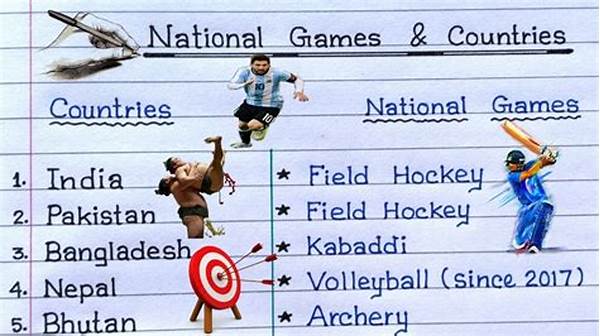Traditional Sports Played In Different Countries

Exploring the world of traditional sports played in different countries offers a fascinating glimpse into the cultural tapestry that binds communities together. These sports demand not only physical prowess but also a deep understanding of local customs and history. Whether it’s the adrenaline of Highland Games in Scotland or the agility tests of Sepak Takraw in Southeast Asia, traditional sports serve as a bridge between generations and a source of national pride. This article will navigate through the globe, uncovering unique traditional sports played, how they’ve evolved, and the significance they hold today.
Read More : Benefits Of Swimming For Asthmatics
In Scotland, the Highland Games are more than a sporting event; they are a celebration of Scottish heritage. From tossing the caber to hammer throwing, these sports challenge even the fittest of athletes. Equally, in Southeast Asia, Sepak Takraw combines gymnastics with soccer, showcasing incredible flair and skill. Both these examples highlight how traditional sports have adapted over time while maintaining their core cultural values. These sports capture local identity and spirit, making them integral to national tradition.
Moreover, these traditional sports played in different countries often serve as an entry point for the world to understand and appreciate diverse cultural narratives. They are not just games; they are vibrant symbols of identity and community spirit. Through competitions and festivals, these sports invite participants from around the globe, fostering a unity that transcends language and geography. As you delve into the realm of traditional sports, prepare to be enthralled by the passion and dedication that each athlete invests in preserving these age-old practices.
The Rich Tapestry of Global Sporting Traditions
Description of Traditional Sports
Traditional sports played in different countries not only entertain but also narrate stories of cultural resilience and change. Each sport carries with it a rich legacy, passed down through generations, acting as a narrative of the society’s values, history, and achievements.
In Bhutan, Archery is not just a sport; it is a cherished cultural practice that symbolizes precision and skill, with roots extending deep into history. In the bustling festivals, the cheerleaders, songs, and dances accompanying each shot make it a community event rather than just a competitive sport. Similarly, in Japan, Sumo wrestling is steeped in rituals and traditions, showcasing not just physical strength but mental discipline and respect, highlighting the intricate balance between ferocity and dignity.
Many of these traditional sports have survived through centuries owing to their cultural significance and the passion with which they are celebrated. Their survival often hinges on local communities’ efforts to maintain these traditions through local events, festivals, and even integration into educational systems. Thanks to modern documentation and sporting leagues, these historic sports have not only been preserved but are enjoying a renaissance as more people globally become fascinated and participate in these cultural legacies.
The Cultural Impact of Traditional Sports
The cultural impact of traditional sports played in different countries is profound, acting as a vessel for transmitting values, stories, and traditions to younger generations. Each game and sport is a living testament to the history and lifestyle of the civilizations that nurtured them.
In Indigenous Australian culture, for instance, the Marngrook, a type of football, underscores community, teamwork, and kinship. Its influence on the modern Australian Rules Football is a testament to how traditional sports can shape new, globally recognized forms of competition. Similarly, the stick-throwing game of Nguni stick fighting, played by Zulu warriors, transcends its original martial training purpose to become a cultural spectacle in modern-day South Africa, blending ancient tradition with contemporary sport.
Read More : Advantages And Disadvantages Of Track Running
As these sports captivate local and international attention, there is an increasing push towards safeguarding these cultural gems in a rapidly globalizing world. They not only promote physical activity but impart life lessons, fostering respect for cultural diversity. With the rise of cultural tourism, traditional sports have transformed into attractions that educate and entertain, while economic benefits flow back to sustain local communities.
Engaging with Traditional Sports: A Global Phenomenon
Traditional sports played in different countries capture a unique allure that transcends the typical competitive atmosphere found in conventional sports. They offer a connection to a shared human heritage and an invitation for others to experience these cherished practices.
Participating in these traditional sports, or even merely observing them, opens avenues for deeper cultural understanding and appreciation. These sports bring together people from diverse backgrounds, fostering dialogue, exchange, and a respectful curiosity across cultural boundaries. From tourists seeking authentic cultural experiences to locals striving to keep their heritage alive, the interest in experiencing or participating in traditional sports is growing at an unprecedented pace.
The potential for cultural exchange and mutual appreciation through traditional sports is vast, allowing for international camaraderie and the strengthening of global ties. Events like international traditional sports festivals provide platforms for cross-cultural interactions, turning sporting arenas into global showcases of cultural pride and unity.
Related Topics on Traditional Sports
Delving into traditional sports played in different countries opens a Pandora’s box of cultural riches, blending history with modernity. The future of these games lies in their ability to adapt while keeping traditions intact. As communities continue to celebrate their unique sporting practices, the world becomes a more connected and colorful place.



